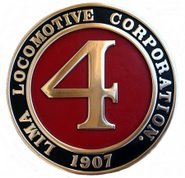Garrett ordered the mega meat lover's breakfast, a meal that comes loaded with hash browned potatoes, scrambled eggs and three breakfast meats.
 It's easy to imagine sausage, bacon and sausages sizzling on a clean shovel. But I forgot one key element to cooking on West Coast Shays.
It's easy to imagine sausage, bacon and sausages sizzling on a clean shovel. But I forgot one key element to cooking on West Coast Shays."Oil-fire locomotives have no coal scoop," said Garrett. He's right.
An experienced locomotive cook and one who has fired historic Shay locomotives, like the Yosemite Mountain Sugar Pine Nos. 10 and 15, Garrtett should know.
Garrett heats burritos, sandwiches and "anything that's packaged" in the engine cab with heat from the backhead. But he doesn't really cook.
There's "no surface with a controllable heat source that you can really cook on," said Gattett.
But the immense heat radiating off the boiler backhead will heat any prepared meal through. It's a matter of locating a good spot to capture the wasted heat.
The theory is simple enough. "Look for a good place to basically jam your food so it doesn't fall out."
Garrett likes several spots, but has no favorite. "It just depends what you're making," said Garrett.
Do you need slow heat? Try the oil can pan that sits above the firebox door. But be sure to wrap the burrito well as things get messy.
Intense heat can be found on the hydrostatic lubricator on the engineer's side of the cab. The four lubricating lines on the Shay are full of steam. Set close together, the lines act "almost like a grill."
It sounds like a good spot to grill a Rubin or grilled cheese sandwich. Just keep it simple and focus on firing the engine.
Any spot will do. All you need is is an exposed steam line, added Garret.
Garrett will sometimes jam a burrito behind the lifting injectors on the fireman's side. He also tucks it up behind the steam turret on top of the backhead. The turret's a great spot because it's the steam source for all accessories in the engine cab.
It's too bad an oil-burning locomotive like the Diamond & Caldor No. 4 Shay doesn't need a coal shovel. Just think of the culinary creations a fireman could cook on its flat griddle-like surface.
The photograph shows the backhead of Roaring Camp & Big Trees Narrow-Guage Railroad No. 1 Shay. Cross posted at 'Round the Chuckbox.





 "This is perfect painting weather. The sun's hot," said Keith. He wanted to get it done before long-overdue rains arrive next week. The high today will be in the mid-70s today in Placerville. The current plan is to keep the body gloss black silver lettering.
"This is perfect painting weather. The sun's hot," said Keith. He wanted to get it done before long-overdue rains arrive next week. The high today will be in the mid-70s today in Placerville. The current plan is to keep the body gloss black silver lettering.